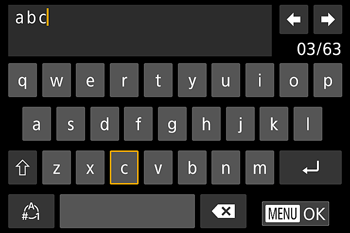Introduction
You can transfer images to a smartphone as follows.
Connect via Bluetooth
You can easily connect the camera to a Bluetooth enabled smartphone by pairing them. This simplifies transferring images to a smartphone.
Connect via NFC
Simply touch an NFC-compatible Android smartphone against the camera to connect the devices.
Connect via the Wi-Fi menu
You can connect the camera to a smartphone as you would connect it to a computer or other device. Multiple smartphones can be added (you can register multiple devices, but the camera can only be connected to one device at a time).
Caution
Before connecting to the camera, you must install the free dedicated Camera Connect app on the smartphone.
Please refer to the "Related information" section at the bottom of this page for specifications and system requirements of the smartphones which can be connected wirelessly.
Interface or functions of Camera Connect are subject to change, for application improvement or update. In such a case, features of Camera Connect may differ from sample screens or operation instructions in this explanation.
Caution
In the following explanation, smartphone setting procedures are indicated by the

icon, and camera setting procedures are indicated by the

icon.
Depending on the condition of the network you are using, it may take a long time to send movies. Be sure to keep an eye on the camera battery level.
When sending movies to smartphones, note that the supported image quality varies depending on the smartphone. For details, refer to the smartphone user manual.
The setting procedures and items may differ depending on the smartphone model you use and its OS. For more information, refer to your smartphone's instruction manual.
On the screen, wireless signal strength is indicated by the following icons: [

] high, [

] medium, [

] low, [

] weak
Connections require that a memory card be in the camera.
Step 1-A: Connect via Bluetooth
 1-A-1. Install Camera Connect.
1-A-1. Install Camera Connect.
For Android smartphones, find Camera Connect in Google Play and download and install the app.
For an iPhone or iPad, find Camera Connect in the App Store and download and install the app.
 1-A-2. Register a nickname.
1-A-2. Register a nickname.
Turn on the camera.
Press the [MENU] button.
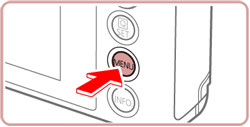
Touch [

], and then touch [4].
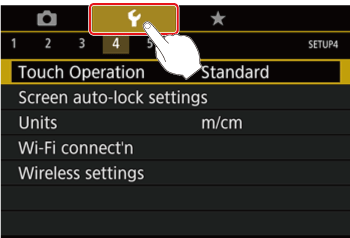
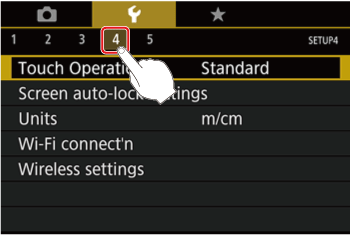
Touch [Wireless settings], and then press the [

] button.
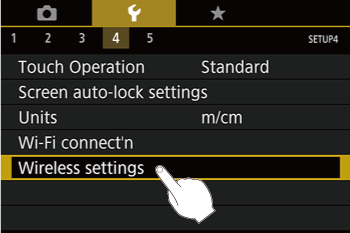
Press the [

] button to access the keyboard, and then enter a nickname.
*For more information on using the keyboard, please refer to "Using the On-Screen Keyboard".
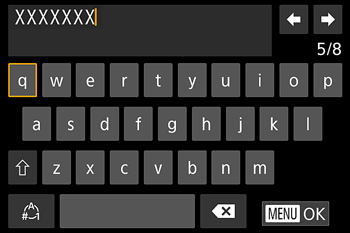
To return to [Wireless settings] after pressing the [MENU] button, press the [MENU] button again.
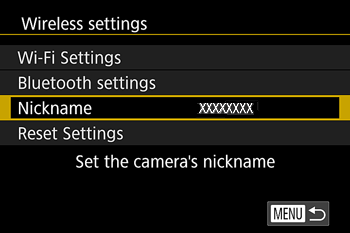
 1-A-3. Prepare for pairing.
1-A-3. Prepare for pairing.
Choose [Bluetooth settings] to choose [Pairing], and then press the [

] button.
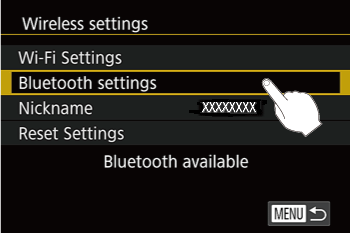

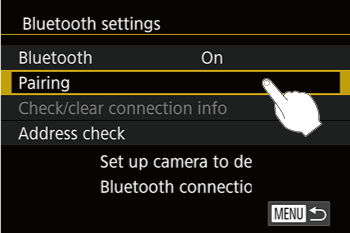
A screen is displayed indicating that the camera is waiting to connect.
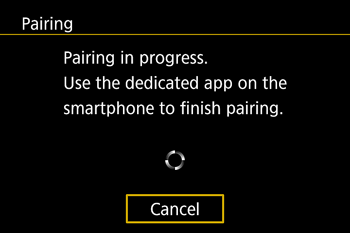
 1-A-4. Start Camera Connect.
1-A-4. Start Camera Connect.
Activate Bluetooth on the smartphone, and then start Camera Connect on the smartphone.
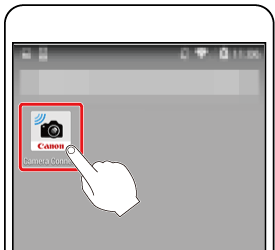
After the camera is recognized, a camera selection screen is displayed.
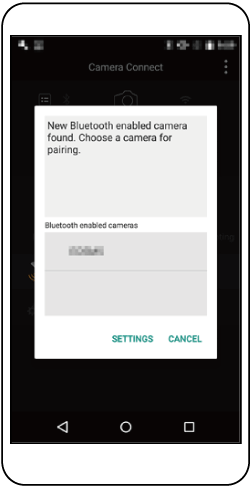
 1-A-5. Select the camera to connect to.
1-A-5. Select the camera to connect to.
Choose the camera nickname.
Complete the pairing process for the smartphone.

 1-A-6. Complete pairing.
1-A-6. Complete pairing.
Choose [OK] after the confirmation message appears on the camera, and then press the [

] button.
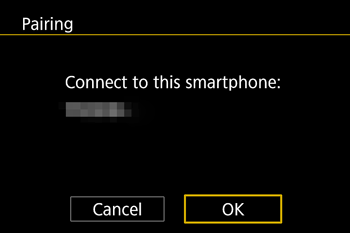
Step 1-B: Connect via NFC
Use an Android smartphone’s NFC to simplify the process of installing Camera Connect and connecting to the camera.
Caution
Operation when devices are initially connected via NFC varies depending on the camera mode when the devices are touched together.
If the camera is in Shooting mode when the devices are touched together, you can choose and send images on the image selection screen. Once the devices are connected, you can also shoot remotely while viewing a shooting screen on the smartphone, or geotag your shots. It’s easy to reconnect to recent devices, which are listed in the Wi-Fi menu.
If the camera is in Playback mode when the devices are touched together, you can choose and send images from the index display shown for image selection.
The procedures for transferring images from the camera to the smartphone when the camera is set to Shooting mode are explained in the following sections.
For information about making connections and transferring images from the camera to the smartphone when the camera is set to Playback mode, please refer to the camera’s instruction manual.
Caution
When using NFC, keep the following points in mind.
If your Camera Connect version is 2.7.10 or later, check the Android OS version of your smartphone. If the version is 10.0 or later, you cannot connect to the camera using NFC functionality.
Avoid strong impact between the camera and smartphone. This may damage the devices.
Depending on the smartphone, the devices may not recognize each other immediately. In this case, try holding the devices together in slightly different positions. If connection is not established, keep the devices together until the camera screen is updated.
Do not place other objects between the camera and smartphone. Also, note that camera or smartphone covers or similar accessories may block communication.

 1-B-1. Install Camera Connect.
1-B-1. Install Camera Connect.
Move the power switch to [ON].
Activate NFC on the smartphone and touch the devices’ N-Marks ( ) together to start Google Play on the smartphone automatically. Once the Camera Connect download page is displayed, download and install the app.
) together to start Google Play on the smartphone automatically. Once the Camera Connect download page is displayed, download and install the app.
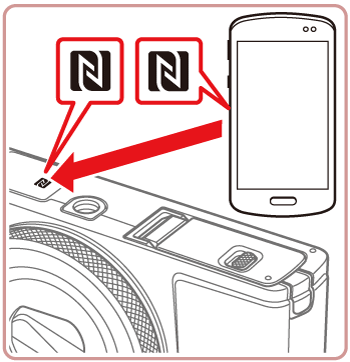
 1-B-2. Establish the connection.
1-B-2. Establish the connection.
Touch the N-Mark (  ) on the smartphone with Camera Connect installed against the camera’s N-Mark.
) on the smartphone with Camera Connect installed against the camera’s N-Mark.
The camera screen automatically changes.
If the [Device Nickname] screen is displayed, touch [OK].
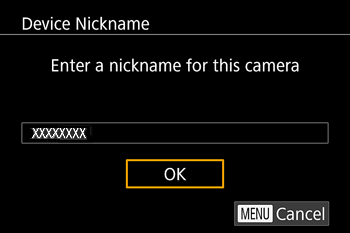
Camera Connect starts up on the smartphone, and the devices are connected automatically.
 1-B-3.Adjust the privacy setting.
1-B-3.Adjust the privacy setting.
When this screen is displayed, touch [Yes].
You can now use the smartphone for remote live view shooting, or to browse, transfer, or geotag images on the camera.
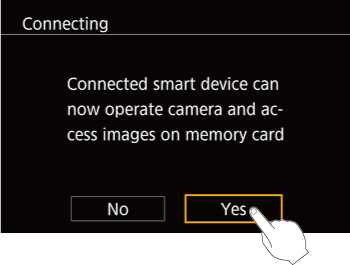
The following screen appears.
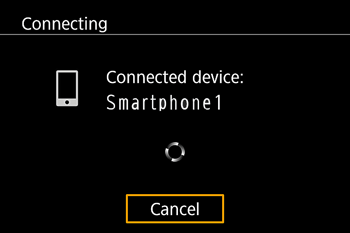
Once you have connected to the smartphone, a screen like the one below will appear.
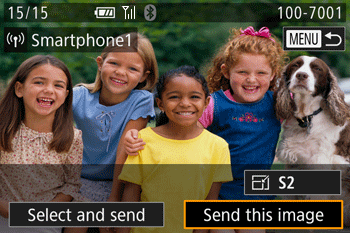
Proceed to Step 2-B: Viewing and Saving Images with the Smartphone.
Caution
Connections require that a memory card be in the camera.
You can also change the camera nickname on the screen in step 1-B-2.
You can also send multiple images at once and change the image size before sending.
To disable NFC connections, choose MENU ⋗ [

- 4] tab ⋗ [Wireless settings] ⋗ [Wi-Fi Settings] ⋗ [NFC] ⋗ [Off].
These steps show how to use the camera as an access point, but you can also use an existing access point.
 1-C-1. Install Camera Connect.
1-C-1. Install Camera Connect.
For Android smartphones, find Camera Connect in Google Play and download and install the app.
For an iPhone or iPad, find Camera Connect in the App Store and download and install the app.
 1-C-2. Access the Wi-Fi menu.
1-C-2. Access the Wi-Fi menu.
Move the power switch to [ON].
Press the [

].
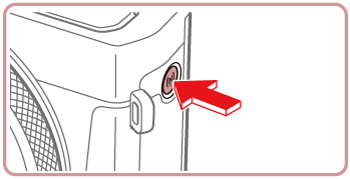
If the [Device Nickname] screen is displayed, touch [OK].

 1-C-3. Choose [
1-C-3. Choose [  ].
].
Touch [

].
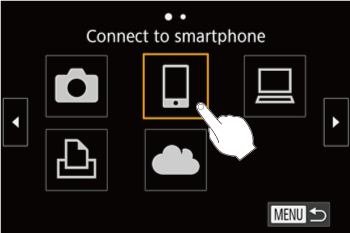
Caution
Connections require that a memory card be in the camera.
Once you have connected to devices via the Wi-Fi menu, recent destinations will be listed first when you access the Wi-Fi menu. Simply touch a listed device to connect again. You can register new devices by dragging left or right to access the device selection screen.
If you prefer not to display recent target devices, choose MENU ⋗ [

- 4] tab ⋗ [Wireless settings] ⋗ [Wi-Fi Settings] ⋗ [Target History] ⋗ [Off].
 1-C-4.Choose [Add a Device].
1-C-4.Choose [Add a Device].
Touch [Add a Device].
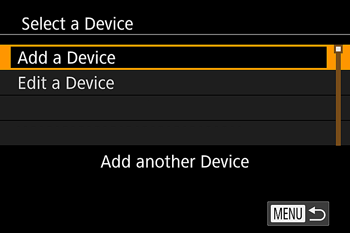
The camera SSID and password are displayed.
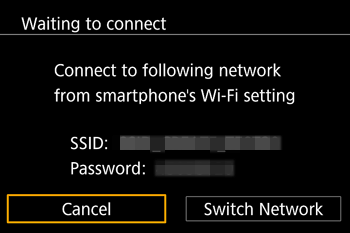
Caution
To connect without entering a password in step 1-C-5, choose MENU ⋗ [

- 4] ⋗ [Wireless settings] ⋗ [Wi-Fi Settings] ⋗ [Password] ⋗ [Off]. Password is no longer displayed on the SSID screen (in step 1-C-4).
 1-C-5. Connect the smartphone to the network.
1-C-5. Connect the smartphone to the network.
In the smartphone’s Wi-Fi setting menu, choose the SSID (network name) displayed on the camera to establish a connection.
In the password field, enter the password displayed on the camera.

 1-C-6. Start Camera Connect.
1-C-6. Start Camera Connect.
Touch the [Canon CC] (

) icon to start the [Camera Connect] app.

 1-C-7. Choose the camera to connect to.
1-C-7. Choose the camera to connect to.
On the camera selection screen displayed on the smartphone, choose the camera to begin pairing.
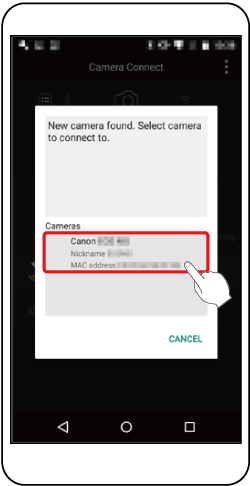
 1-C-8.Adjust the privacy setting.
1-C-8.Adjust the privacy setting.
When this screen is displayed, touch [Yes].
You can now use the smartphone for remote live view shooting, or to browse, transfer, or geotag images on the camera.

The following screen appears.

Step 2-A: Transferring Images to a Bluetooth Enabled Smartphone
 2-A-1. Touch [Images on camera] in Camera Connect.
2-A-1. Touch [Images on camera] in Camera Connect.
The camera will automatically switch to Wi-Fi if you choose [Images on camera] in Camera Connect.
On an iPhone or iPad, in the device’s Wi-Fi setting menu, choose the SSID (network name) displayed on the camera to establish a connection.
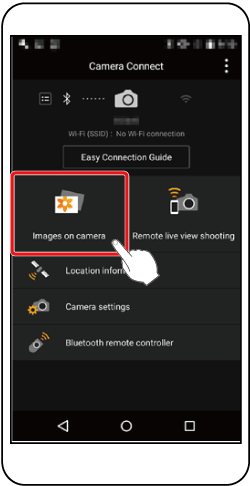
 2-A-2. Use the smartphone to import images from the camera to the smartphone.
2-A-2. Use the smartphone to import images from the camera to the smartphone.
When the camera is connected to the smartphone, a list of the images on the camera will appear in [Camera Connect]. Tap [Select] appearing in the upper right of the screen.
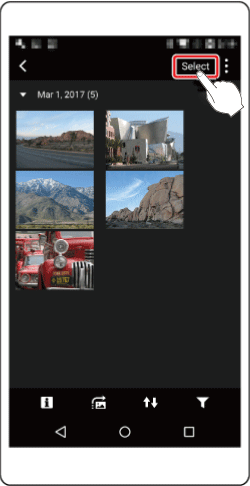
To switch to Bluetooth, disable the Wi-Fi connection on the smartphone.
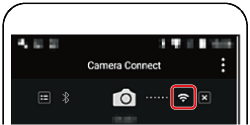

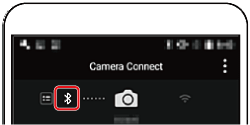
Caution
Bluetooth connection status is indicated by one of the following icons: [

]: Connected; [

]: Disconnected
To disable Bluetooth communication, choose MENU ⋗ [

- 4] tab ⋗ [Wireless settings] ⋗ [Bluetooth settings] and set [Bluetooth] to [Off].
To check the information of the smartphone connected via Bluetooth in [Check/clear connection info], choose MENU ⋗ [

- 4] tab ⋗ [Wireless settings] ⋗ [Bluetooth settings]. Choose [Address check] to check the camera’s Bluetooth address.
Step 2-B: Viewing and Saving Images with the Smartphone
 2-B-1. Touch [Images on camera] in Camera Connect.
2-B-1. Touch [Images on camera] in Camera Connect.
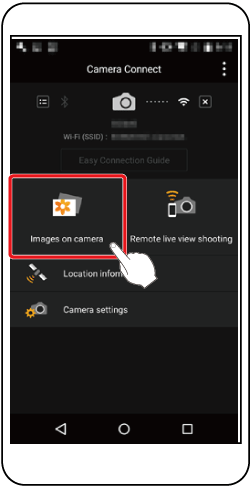
 2-B-2. Use the smartphone to import images from the camera to the smartphone.
2-B-2. Use the smartphone to import images from the camera to the smartphone.
When the camera is connected to the smartphone, a list of the images on the camera will appear in [Camera Connect]. Tap [Select] appearing in the upper right of the screen.

 icon, and camera setting procedures are indicated by the
icon, and camera setting procedures are indicated by the  icon.
icon.  ] high, [
] high, [  ] medium, [
] medium, [  ] low, [
] low, [  ] weak
] weak

 ], and then touch [4].
], and then touch [4]. ] button.
] button.
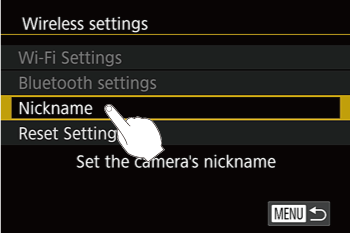

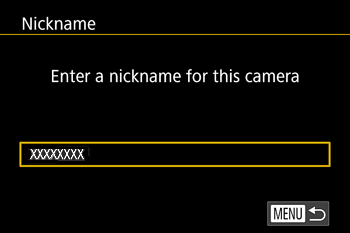
 ] button to access the keyboard, and then enter a nickname.
] button to access the keyboard, and then enter a nickname.


 ] button.
] button.






 ] button.
] button.
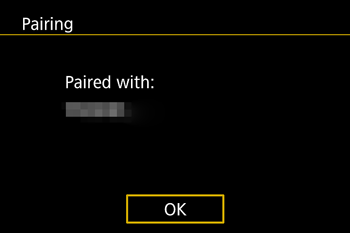










 - 4] tab ⋗ [Wireless settings] ⋗ [Wi-Fi Settings] ⋗ [NFC] ⋗ [Off].
- 4] tab ⋗ [Wireless settings] ⋗ [Wi-Fi Settings] ⋗ [NFC] ⋗ [Off].

 ].
].



 ].
].
 - 4] tab ⋗ [Wireless settings] ⋗ [Wi-Fi Settings] ⋗ [Target History] ⋗ [Off].
- 4] tab ⋗ [Wireless settings] ⋗ [Wi-Fi Settings] ⋗ [Target History] ⋗ [Off].


 - 4] ⋗ [Wireless settings] ⋗ [Wi-Fi Settings] ⋗ [Password] ⋗ [Off]. Password is no longer displayed on the SSID screen (in step 1-C-4).
- 4] ⋗ [Wireless settings] ⋗ [Wi-Fi Settings] ⋗ [Password] ⋗ [Off]. Password is no longer displayed on the SSID screen (in step 1-C-4).


 ) icon to start the [Camera Connect] app.
) icon to start the [Camera Connect] app.















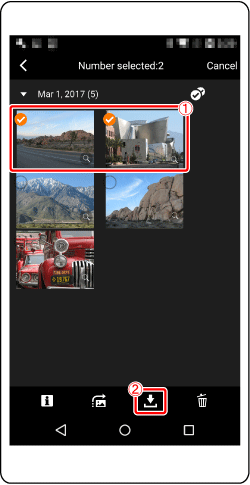



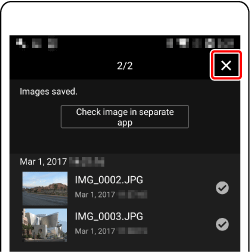

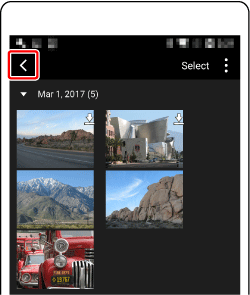


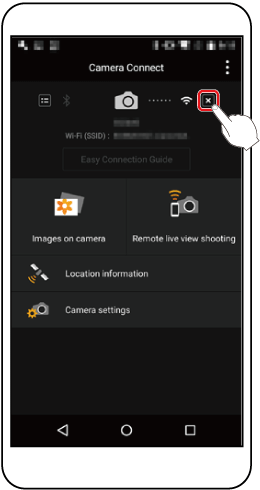

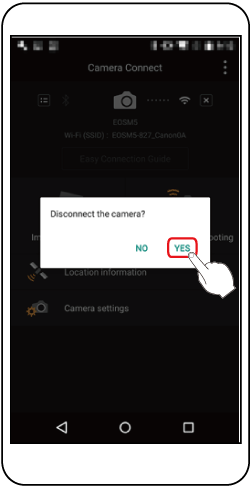
 ]: Connected; [
]: Connected; [  ]: Disconnected
]: Disconnected - 4] tab ⋗ [Wireless settings] ⋗ [Bluetooth settings] and set [Bluetooth] to [Off].
- 4] tab ⋗ [Wireless settings] ⋗ [Bluetooth settings] and set [Bluetooth] to [Off]. - 4] tab ⋗ [Wireless settings] ⋗ [Bluetooth settings]. Choose [Address check] to check the camera’s Bluetooth address.
- 4] tab ⋗ [Wireless settings] ⋗ [Bluetooth settings]. Choose [Address check] to check the camera’s Bluetooth address.






















 .
. .
. .
. to enter capital letters.
to enter capital letters. to delete the previous character.
to delete the previous character. button.
button. is not displayed and cannot be used.
is not displayed and cannot be used.